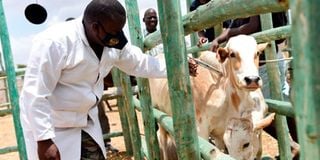Premium
Why vets can’t rely on videos, photos to treat diseases

A veterinary officer in Kaloleni, Kilifi County, vaccinates an animal in November 2021.
What you need to know:
- Even in medicine, there are many areas where the technology has reduced the burden of diagnosis, treatment and disease control.
- Even with all those benefits of digital technology in medicine, there are many occasions where physical examination must be done.
I have come to the conclusion that people are overrating the utility of digital technology particularly in some service disciplines like medicine.
Let me first put a disclaimer that I am in no way demeaning the value of digital technology in the various aspects of human socio-economic development.
Even in medicine, there are many areas where the technology has reduced the burden of diagnosis, treatment and disease control. Our minds are still fresh with the role of digital technology in the control of the Covid-19 pandemic.
From the onset of the pandemic, information was voluminous to the point it was termed an “infodemic”. The information flow was highly adequate, efficient and effective until almost everyone became an expert in control of the disease globally.
The Covid-19 digital information flow demonstrated that the general population could quickly learn and internalise complex medical and scientific terms in a very short time. Words like sanitisation, positivity rate and patient zero, which were previously the preserve of public health practitioners, became household terms.
However, even with all those benefits of digital technology in medicine, we still have many occasions where the trodden path of physical examination must be followed. I have increasingly got enquiries for phone diagnosis especially through WhatsApp photos and video clips.
Sometimes I am able to make definitive diagnosis but often times, my recommendation is for the farmer to contact their nearest animal service health provider for a physical examination and diagnosis.
This week, Ndwiga from Kirinyaga sent me a photo of his cow with a large swelling on the jaw at the junction with the neck. He said the swelling had been growing for the last one month. The rate of growth had accelerated in the last two weeks.
I have also received photos of cattle with swellings on various parts of the body and the owners wanted to know the diagnosis and get prescriptions for the medicines to buy.
Ndwiga was not contented with my advice to contact his nearest animal health service provider. He wondered why I insisted on physical examination. He added this was the era of digital technology. Well, I understood his point of view, but then medical practice has standards that require a doctor to make clinical diagnosis deduced from evidence collected through verifiable observation.
Verifiable observation is based on several aspects of the human senses, including the sense of sight, touch and smell. A WhatsApp photo only gives sight-based evidence. One cannot discern the depth, consistency and texture of a swelling that would be provided by the sense of touch. One cannot also tell if the swelling has any smell. As doctors, we scientifically know certain smells are associated with some specific organisms because of the changes they cause in tissues.
I explained to the farmer that swellings on the external body parts of a cow are caused by many different factors. The most common are physical injuries. Such swellings will usually heal without treatment. Some may, nonetheless, develop into hard tissue masses or cavities full of uninfected clear fluid. The latter are called seromas and may sometimes require to be drained through surgery.
The second most common cause of swellings is infections following injuries or by bacteria and other organisms coming from inside the body. Some swellings may only involve the soft tissues while others bones and tendons. In Ndwiga’s case, the swelling could even have been affecting the lymph node in the junction of the neck and the mandible.
Swellings due to bacteria may contain pus and they are called abscesses but some bacteria like the wooden tongue and tuberculosis ones just cause hardened tissue.
Swellings caused by viruses and fungi on the skin are usually localised on the skin and their shape and size depends on the infecting micro-organism.
Swellings on the skin of cattle may also be caused by cancerous tissue. Some forms of cancer will affect the skin surface while others organs under the skin such as lymph nodes or subcutaneous tissues. Some may also affect bones and appear as skin swellings if the area affected has very little muscle cover.
By the end of the explanation, Ndwiga said he clearly understood why digital technology could sometimes not be used to directly provide observations sufficient for the doctor to make diagnosis and prescribe treatment.
He later confirmed his cow had a bacterial infection that was in the process of forming an abscess. He had contacted his animal health service provider.
The swelling was treated with hot water massage for seven days. This is called hot fomentation, which helps the body fight off the bacteria and form pus.
Once the pus is well-formed, the swelling becomes soft and is then ready to be opened surgically and drained. It is cleaned with hydrogen peroxide and iodine. Antibiotic spray is applied on the wound. Further treatment is given with injected antibiotics to prevent the bacteria from spreading into the bloodstream or other tissues.





